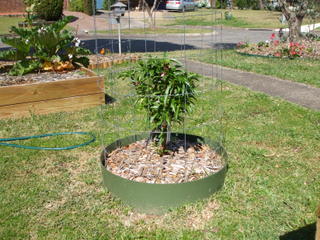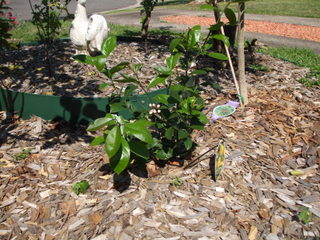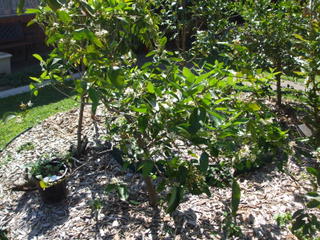If you have a small space you need to plan to get the most out of it and that’s what we did when we developed the veggie planting guide, we developed a plan that allowed us to harvest veggies all year round. Using a slightly different process it is possible to develop a plan that allows you to harvest fruit all year round too.
As always the thing to do first is to work out the sorts of fruit that you want to eat and while we will be talking about fruit trees, don’t neglect berry fruit like strawberries or blackberries or vine fruit such as kiwis, passionfruit and grapes as well. Once you have an idea of the sort of fruit you want to grow draw up a harvest calendar by drawing up a table with 14 columns and as many rows as you want, you can always add more. The very left hand column is for the type of fruit (apple, orange, grape, mango etc) and the second column is for the variety (for apples you might want a granny smith and a red delicious, or a beurre bosc pear etc). The next twelve columns are one per month so start where you want, January is as good a place as any and then work through for a full 12 months. 
There is an example of our fruit harvest calendar available for download in the resources section of the site, it is in Word format so you can take it and then plug in your own varieties if you wish.
As you work out what fruit and varieties you want there are several aspects of fruit growing that will modify your choices –
Family tastes – where possible actually try some fruit from your chosen type and variety and give your family a go at it too. It doesn’t matter how pretty or productive the tree is, if nobody eats the fruit you have done your dough.
Climate - There are very few areas that will allow you to grow any sort of fruit that you want so you do need to be aware of the types of fruit that grow well in your area and you can do this by hitting the books or the internet but if you have access to local fruit gardeners they will be your most reliable source. Don’t make the mistake of thinking that if Bunnings sell it in your area that it must grow well, they are in business to sell all sorts of stuff and if you buy it and it doesn’t grow that is your bad luck. To prevent frustration, heartache and some financial loss do your research before putting a spade anywhere near your garden.
Pollinators – some fruits like pome and stone fruits will need to have two compatible varieties that will act as pollinators for each other. Even if the variety you have chosen is regarded as self fruitful under some conditions, a pollinator tree will ensure a better harvest. Pollinators will flower about the same time and provide pollen that fertilises the target plant. More research needed.
Sexuality – no not your sexuality silly, the sexuality of the tree! Some trees have male and female flowers and so are self fertile (mostly – see pollinators above) but some have male and female trees (these are called dioecious). After spending 15 years growing up a lovely Carob tree the thing finally flowered and it turned out to be a male and at the time I bought it I had no idea that the carob species was dioecious so I would never get fruit off it. It was a happy ending though and it kept us warm during a fair chunk of last winter. Again, do your research and find out if one tree will be fruitful or if you need a male and female to get fruit. I do believe these days that self fruitful carobs are around.
So now you have a list of the species and varieties of fruit that you want, written down on the two left hand columns of your calendar. If you already have some fruit trees etc in place that is no problem, put them down on the calendar in a different colour so you can distinguish what you have from what you need to get.
Now for the fun bit, hit the books, net, local gardeners, botanic gardens or whatever and find out what months of the year each of your fruit varieties produces fruit. It is not enough to get some general idea of when oranges bear fruit, when does the variety you have selected bear fruit in your area? The more accurate your information, the better the likelihood will be of getting year ‘round fruit out of your mini orchard. At the very least check out the books I have listed in the “library” section of the site and see if your library can get any of them in for you. Another book which I don’t have is “The Complete Book of Growing Fruit in Australia” by Louis Glowinski which is also worth a look.
As you gather your information, from whatever source you can manage, make a mark (cross, tick, coloured square or whatever) in the columns for the months that the plant fruits along the line of each fruit/variety. Once you have completed this part of the process it will become immediately obvious if there are any blank spaces in the year when you won’t have fruit available for harvest.
So now it is time to hit the books again, but this time to look for fruits that you can harvest to fill in any “hungry gaps” in your fruit calendar. Remember to make sure it is something your family will eat and if they haven’t tried it see if you can get hold of a sample fruit from your local greengrocer or wherever and try it out. You never know it might be the tastiest fruit you have ever tried, but if it is gross cross it off the list and move on.
Once all the spots in your calendar are filled you can buy the fruits you don’t have and complete your mini-orchard. How many you buy of each tree, bush or vine will depend on how much space you have and how much you like each fruit. If you don’t have lots of space you will have to get creative and try fruit in pots, pruning to get the best yield for space such as by espaliering some trees along a fence line or the edge of one of your buildings or going for genetic dwarf trees or trees grafted onto dwarfing rootstocks. If you have friends and family around you consider putting some on their land or even put some time into developing a community orchard.
However you manage to put it into practice, your fruit harvest calendar will help you set things up so that you and your family will have fresh, home produced, organic fruit all year round and what could be better than that?



